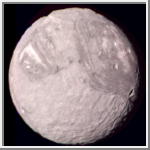 Miranda - Color Picture
Miranda - Color Picture
This color composite of the Uranian satellite Miranda was taken by Voyager 2 on January 24, 1986, from a distance of 147,000 kilometers (91,000 miles). Miranda's regional geologic provinces show very well in this view of the southern hemisphere, imaged at a resolution of 2.7 kilometers (1.7 miles). The dark- and bright-banded region with its curvilinear traces covers about half of the image. Higher-resolution pictures taken later show many fault valleys and ridges parallel to these bands. Near the terminator (at right), another system of ridges and valleys abuts the banded terrain; many impact craters pockmark the surface in this region. The largest of these are about 30 kilometers (20 miles) in diameter; many more lie in the range of 5 to 10 kilometers (3 to 6 miles) in diameter. (Courtesy NASA/JPL)
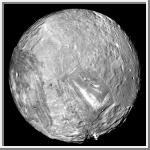 Orthographic Image of Miranda
Orthographic Image of Miranda
This image is an orthographic image of Miranda centered at the south pole. Zero degrees logitude, which is the central longitude of the side facing Uranus, is at the bottom. The image was computer-assembled from images obtained January 24, 1986, by the Voyager 2 spacecraft. Miranda is the innermost and smallest of the five major Uranian satellites, just 480 kilometers (about 300 miles) in diameter. This image is a full-disc, south-polar view of the moon showing the varying geologic provinces of Miranda. The moon's surface consists of two major strikingly different types of terrain. One is an old, heavily cratered, rolling terrain with relatively uniform albedo, or reflectivity. The other is a young, complex terrain characterized by sets of bright and dark bands, scarps and ridges. These are features found in the ovoid regions at right and left and in the distinctive chevron feature below and right of center. (Courtesy A. Tayfun Oner)
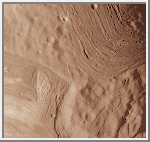 The Chevron
The Chevron
This view of Miranda shows details as small as 600 meters across. It was acquired by Voyager 2 on January 24, 1986. This is a close-up view of the chevron which shows the light and dark grooves with its sharp boundaries. The upper right shows a region of uniformly dark grooved terrain. The area shown is about 150 kilometers (93 miles) on a side. (Credit: Calvin J. Hamilton)
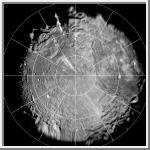 Polar Stereographic Map of Miranda
Polar Stereographic Map of Miranda
This image is a polar stereographic map of the southern hemisphere of Miranda. Zero degrees longitude is at the top. (Courtesy A. Tayfun Oner)
 Cylindrical Map of Miranda
Cylindrical Map of Miranda
This image is a simple cylindrical map projection of Miranda. Zero degrees longitude is at the center and 1 pixel equals 1 kilometer at the equator. (Courtesy A. Tayfun Oner)
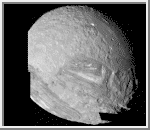 High Resolution Mosaic
High Resolution Mosaic
This computer-assembled mosaic of Miranda includes many of the high-resolution frames obtained by Voyager 2 during its close flyby of the Uranian moon. Miranda, roughly 500 kilometers (300 miles) in diameter, exhibits varied geologic provinces, seen in this mosaic of clear-filter, narrow-angle images from January 24, 1986. The images were obtained from distances of 30,160 to 40,310 kilometers (18,730 to 25,030 miles); resolution ranges from 560 to 740 meters (1,840 to 2,430 feet). These are among the highest-resolution pictures that Voyager has obtained of any of the new 'worlds' it has encountered during its mission. On Miranda, ridges and valleys of one province are cut off against the boundary of the next province. Probable compressional (pushed-together) folded ridges are seen in curvilinear patterns, as are many extensional (pulled-apart) faults. Some of these show very large scarps, or cliffs, ranging from 0.5 to 5 kilometers (0.3 to 3 miles) in height -- that is, higher that the walls of the Grand Canyon on Earth. (Courtesy NASA/JPL)
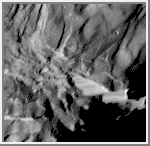 High Resolution of Large Fault
High Resolution of Large Fault
This high-resolution image of Miranda was acquired by Voyager 2 on January 24, 1986, when the spacecraft was 36,250 kilometers (22,500 miles) from the Uranian moon. In this clear-filter, narrow-angle image, Miranda displays a dramatically varied surface. Well shown at this resolution of 660 meters (2,160 feet) are numerous ridges and valleys -- a topography that was probably produced by compressional tectonics. Cutting across the ridges and valleys are many faults. The largest fault scarp, or cliff, is seen below and right of center; it shows grooves probably made by the contact of the fault blocks as they rubbed against each other (leaving what are known as slickensides). Movement of the down-dropped block is shown by the offset of the ridges. The fault may be 5 kilometers (3 miles) high, or higher than the walls of the Grand Canyon on Earth. (Courtesy NASA/JPL)
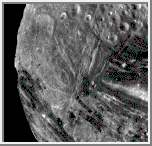 Fractures, Grooves and Craters
Fractures, Grooves and Craters
This Voyager 2 image of Miranda was taken January 24, l986, from a distance of about 31,000 kilometers (19,000 miles), shortly before the spacecraft's closest approach to the Uranian moon. The high resolution of 600 meters (2,000 feet) reveals a bewildering variety of fractures, grooves and craters, as well as features of different albedos. This clear-filter, narrow-angle view encompasses areas of older, heavily cratered terrain with a wide variety of forms. The grooves and troughs reach depths of a few kilometers (or miles) and expose materials of different albedos. The great variety of directions of fracture sand troughs, and the different densities of impact craters on them, signify a long, complex geologic evolution of this satellite. (Courtesy NASA/JPL)

 Uranus
Uranus Puck
Puck Ariel
Ariel